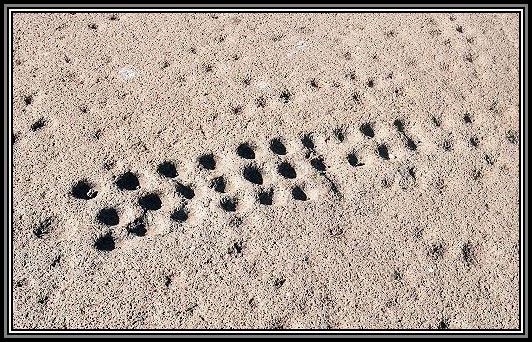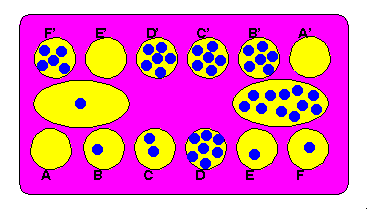During the past decade (circa mid 1980s to mid
1990s) the Life Sciences Department at Palomar College conducted a number
of natural history field courses to the Caribbean region, including the
islands of St. John, Grand Cayman, Antigua and Dominica. On several of
these islands we discovered a popular board game called "Island Wari"
played with "nickernuts," the marblelike seeds of a spiny native shrub.
The game became a popular past-time with students and instructors (during
free hours when we were not diligently studying the indigenous flora and
fauna of these islands). Island Wari (also spelled warie and wauri) is one
version of similar board games called "Wari" that are played in various
parts of the world. They are generally known by the Arabic name "Mancala"
and have been played for thousands of years in Egypt, where "boards" have
been carved into the stone of the pyramid of Cheops and the temples at
Luxor and Karnak. Asante kings played the game on beautiful boards made of
ivory and gold, and today in some rural areas of Africa children play this
ancient game on "boards" scooped out of the ground. African slaves brought
Mancala games to the Caribbean during the 18th and 19th centuries when many
of these islands were denuded of vegetation and planted in sugar cane for
the production of sugar and rum. Legend has it that Black Beard the Pirate
introduced the game to Grand Cayman after one of his voyages to Africa.
Island Wari was reportedly a favorite of Ernest Hemingway each time he
visited this lovely island.
Like the European game of chess, the ancient
African Wari is a fascinating strategy game, but unlike chess it can be
played with the simplest of objects, including stones, sea shells or seeds.
In the Caribbean region Island Wari is commonly played with gray or yellow
nickernuts (Caesalpinia bonduc and C. major),
two common coastal shrubs with marblelike drift seeds that wash into the
sea where they ride the ocean currents of the world.
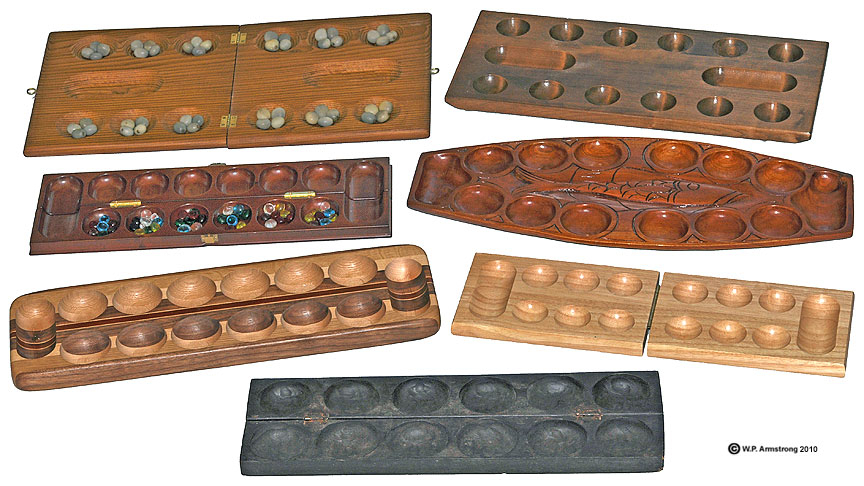

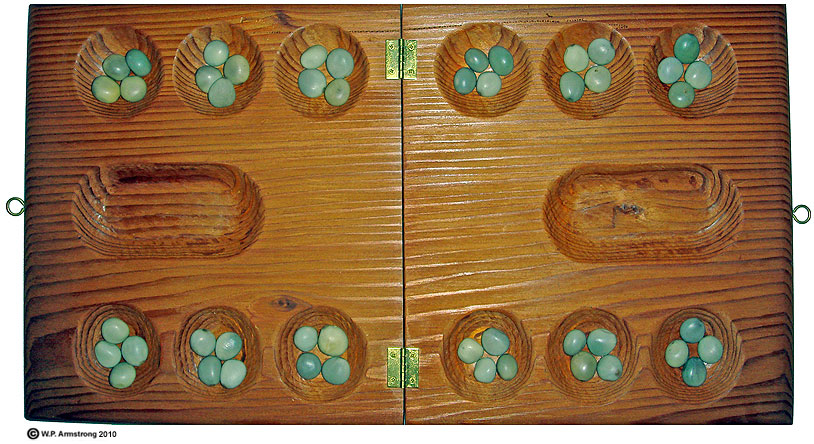

Island Wari is one of several versions of Wari (often referred to as Mancala games). Island
Wari is played on a rectangular board with a row of 6 cuplike depressions
or wells on each side AND a larger well at each end (between the 2 rows).
Depending on who wrote the description, these wells are referred to as
"bins," "cells," or "houses." Two players sit opposite each other
(and opposite the 6 wells on either side of the board). The larger end
well to the right of each player (as they face the board) is their "home
base." Four nickernuts are placed in each of the 6 wells on both sides of
the board (a total of 48) and the 2 home base wells are left empty. In the
following diagram the wells are labeled A, B, C, D, E and F for one player
and A', B', C', D', E'and F' for the opposing player on the opposite side
of the board. For each player the wells are labeled from left to right,
and each move is always made to the player's right (i.e. counterclockwise
on the board).
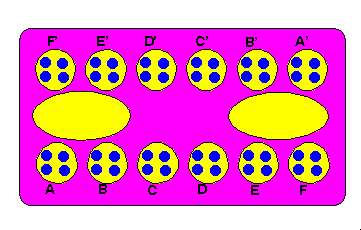
The toss of a coin determines which player shall
start first. Moves are always counterclockwise (to each players's right)
and consist of taking all 4 nickernuts out of a well on YOUR SIDE OF THE
BOARD and placing one seed in each of the successive wells in a
counterclockwise fashion. [As the game progresses, a move may involve more
than 4 seeds, as nickernuts are moved around the board and accumulate in
certain wells.] A seed is also placed in YOUR HOME BASE, but never in your
opponent's home base. If your last seed ends up in YOUR HOME BASE you get
another turn. In fact, this can be very good strategy to make sure you get
another turn.
The object of Island Wari is to clear all of the
6 wells on your side of the board before your opponent can clear their
side. To do this you must move the seeds to your home base and to your
opponent's side of the board (but never to your opponent's home base).
This requires a considerable amount of strategy and a lot of careful
counting in order to prevent seeds from ending up on your side of the board
again. Remember: The first person to clear their side of the board wins
the game.
In the following illustrations your side of the
board is shown as A, B, C, D, E and F, and your opponent's side is shown as
A', B', C', D', E' and F'. We will start with a board at the initial stage
of the game (i.e. with 4 seeds in each well--except for the 2 empty home
base wells):

Let's say that you won the toss and get the first
turn. You pick up all the 4 seeds in well C and place one seed in wells D,
E, F and your home base. Since your last seed landed in your home base you
get another turn--but we won't show another move now.

Now your opponent picks up all the
4 seeds in their well E' and places one seed in their well F', their home
base, and your wells A and B.

Now you pick up all the 5 seeds in your
well F and place one seed in your home base (making a total of 2) and one
seed in your opponent's A',B',C' and D'.

In another move you pick up all the 5 seeds in
your well B and place one seed in wells C, D, E, F and your home base.
Because your last seed landed in your home base you get another turn.

In the next example you pick up the seed in your
well F and place it in your home base, thus giving you another turn.

In the last example let's say you pick up all the
6 seeds in your well E and place one in your well F, one in your home base,
and one in your opponent's wells A', B', C' and D'. Notice the number of
seeds in different wells on the board: 5 in your home base, none in your
wells B and E, 6 in your opponent's wells A', B', C' and D', etc.

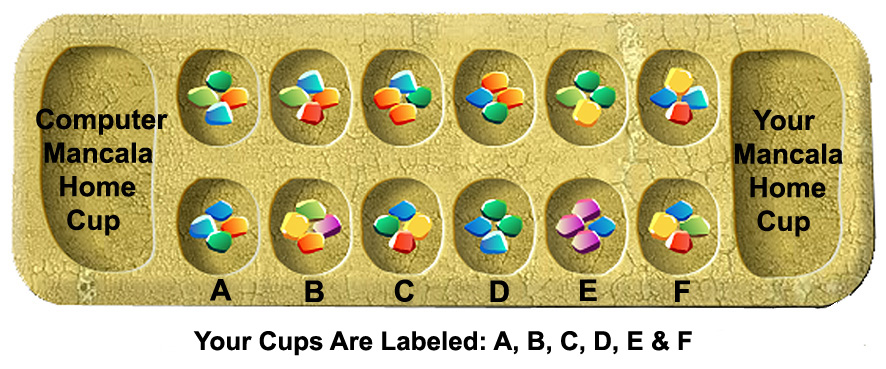 If your skill level in this game is like mine, you are probably having great difficulty winning against the computer. Steve Gunner has posted an excellent YouTube video showing all the correct moves needed to beat the computer. I have listed all the moves in order (left to right) by the letter of your cup (A through F). Each letter refers to the cup on your side of the board. The number that appears when you mouse-over a cup is the number of gems in that cup. When it is your turn simply click on the correct cup. You must keep track of the letter of each cup that you click, otherwise you may click on the wrong cup when it is your turn again. Remember, you start by clicking on Cup C. You will get an extra turn so next click on Cup F. From here on, your turn will come up after the computer has its turn. So when your next turn comes up click on Cup E, and so forth.
|
